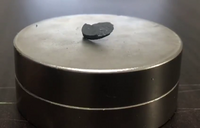
Photo from wikipedia
Room-temperature-superconducting Tc measured by high pressure in hydrides can be theoretically explained by a Brinkman–Rice (BR)–Bardeen–Cooper–Schrieffer (BCS) Tc combining both the generalized BCS Tc and the diverging effective mass, m*/m = 1/(1… Click to show full abstract
Room-temperature-superconducting Tc measured by high pressure in hydrides can be theoretically explained by a Brinkman–Rice (BR)–Bardeen–Cooper–Schrieffer (BCS) Tc combining both the generalized BCS Tc and the diverging effective mass, m*/m = 1/(1 − (U/Uc)2), with the on-site Coulomb interaction U in the BR picture. A transition from U in a correlated metal of the normal state to Uc in the superconducting state can lead to superconductivity, which can be caused by volume contraction induced by high pressure or low temperature.
Journal Title: Scientific Reports
Year Published: 2021
Link to full text (if available)
Share on Social Media: Sign Up to like & get
recommendations!